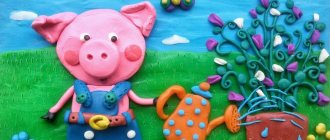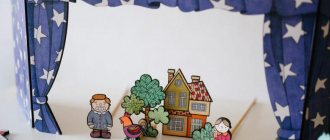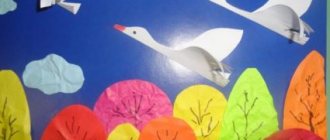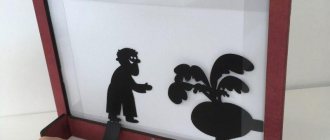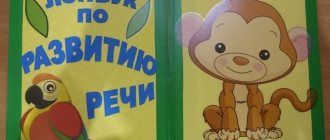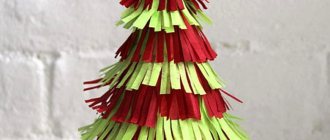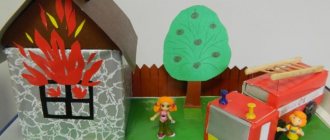MAGAZINE Preschooler.RF
Project activity “DIY children’s themed books”Completed by: Teacher-speech therapist Smirnova I.A. r.p. Tonkino 2022 Municipal budgetary preschool educational institution kindergarten No. 5 “Fairy Tale”
Relevance:
Fiction in the light of the Federal State Educational Standard for Pre-Speech Development includes... acquaintance with book culture, children's literature, listening comprehension of texts of various genres of children's literature... (clause 2.6 of the Federal State Educational Standard for Preliminary Education). ARTISTIC AND AESTHETIC DEVELOPMENT involves the development of prerequisites for value-semantic perception and understanding... of fiction, folklore; stimulating empathy for characters in works of art (clause 2.6 of the Federal State Educational Standard for Education).
Nowadays, children have reduced interest in fiction.
How to introduce a child to reading? Many will consider that in our age, the age of development of computer and other technical technologies, it is irrelevant to talk about books and reading.
A book can enter a child’s world as early as possible, enrich this world, make it interesting, full of extraordinary discoveries. The child will love the book and reach for it if there is motivation and interest. Books have a special charm, books bring us pleasure, they talk to us, give us good advice, they become living friends for us.
The urgency of solving this problem is obvious. To develop a reader in a child, an adult must himself show interest in a book, understand its role in a person’s life, know the books recommended for preschool children, be able to have an interesting conversation with children and help in analyzing the work.
Problem:
Waning interest in fiction.
Goal: To develop interest in fiction in children of middle preschool age.
Tasks:
- To form in children an understanding that a book is a source of knowledge.
- Cultivate interest in books and a caring attitude towards them.
- Arouse positive emotions when reading books.
- Encourage parents to engage in joint productive activities.
Type: informational - educational, creative.
Duration: short term
Participants: middle school children, teachers, parents, speech therapist.
Expected result:
- Increasing children's interest in reading and fiction.
- Enrichment of vocabulary, development of lexical and grammatical structure, coherent speech of children.
- Increasing the level of children's speech development.
- Active participation of parents in the life of the kindergarten.
- Positive attitude of parents in joint activities with teachers.
- Revival of reading in the family circle.
Stages of work on project activities:
Stage 1: Organizational
- Determining the theme of the project.
- Formulation of goals and objectives. Familiarizing children and parents with the goals and objectives of the project.
- Drawing up a plan for the main stage of the project. Selection of material. Survey of children.
- Selection of didactic and methodological equipment for the project.
- Decision making: implementation of the “Do it yourself book”
Stage 2: Practical
- Speech development: “The Tale of the Wise Mother Earth and her three assistants (Droplet, Ray and Svetik) .
- Cognition: “Water” , “How books are born” .
- Construction of a “Little book with your own hands” .
- Application: Compiling a book “Spring” , “Water” .
- Reviewing different books of different types and genres.
- Conversations: “Take care of the book” , “Why are books needed” , “Where do books live? ”
- Role-playing game "Library" .
- Speech game “Which one, which one” ,
- Didactic game: “Moneybox of new words” , “Guess the riddle” , “Choose a word” , “One, two, three, turn the picture and tell us .
- Productive activity: game “Treating a book”
- Joint creativity: “In a fairy-tale world” (writing fairy tales about water, etc.).
Stage 3: Final
- During the implementation of the project, all points of the plan are carried out step by step, the results are analyzed
- collecting the received material for the project,
- project implementation report.
Implementation of project activities:
- Directly educational activities.
- Joint activities of teachers and children;
- Work of teachers with parents;
- Creation of a subject-development environment.
- Joint free activities of children and parents.
Forms and methods of work
Homework for children and parents: create a little book on the lexical topics covered" "My favorite book"
Collective production of the book “Seasons” .
In addition to practicing lexical topics, practice the ability to identify the first and last sound, first and last letter in a word, the ability to determine the number of syllables in words, and compose not only sentences with given words, but also stories.
Collective design of a book, where each child has his own page, or joint production of a book for each child with an adult.
During the work on the project, we came to the conclusion that such activities, games, and productive activities unite children with common impressions, experiences, emotions, and contribute to the formation of collective relationships. We really hope that the work we do will help children fall in love with books and instill in children a desire to read and make books themselves and write stories.
What is “good” about a homemade book?
- A homemade book is a product of a child’s creative efforts, designed to instill respect for one’s own and others’ creativity.
- A homemade book is a great opportunity for children and adults to communicate and create something smart, beautiful and useful together.
- In the process of making a book, the child’s speech, creative thinking and fine motor skills develop.
| Next > |
Project for children “Creating a book with your own hands”
Ekaterina Tarmaeva
Project for children “Creating a book with your own hands”
Educator: Maslova V.S.
Project type : practice-oriented
Project duration : short-term (2 weeks)
.
Relevance of the project :
The process of communication between a preschool child and a book is a process of developing his personality. A book should enter a child’s world as early as possible, enrich this world, make it interesting, full of extraordinary discoveries. A child should love a book and reach for it.
But, as you know, modern children increasingly spend their time playing computer games, watching TV shows and reading books .
In conditions where are being created , it is difficult to force a child to pick up a book , especially a preschooler, since he is a kind of reader. The word "reader"
relative to preschool age conditionally.
In reality, it is the listener whose encounter with the book is completely determined by the adult, from the choice of text to read to the duration of communication with the book . Taste, interest in a work, its interpretation, the ability to navigate the circle of children's reading, the creation of a reading system - all this is in the power of an adult. It largely depends on the adult whether the child will become a real, enthusiastic reader, or whether a meeting with a book in preschool will be a random, meaningless episode in his life.
The attitude a child develops towards the process of reading and towards literature also depends on the attitudes of the adult.
Today, the relevance of solving this problem is obvious, because reading is associated not only with literacy and education. It forms ideals, broadens one’s horizons, and enriches a person’s inner world. Books have a special charm: books give us pleasure, they talk to us, give us good advice, they become living friends for us .
Objective of the project :
For children :
Create a book with your own hands
For the teacher:
Create motivation for parents to speak together
howling and visual activities with the child at home
Organize an exhibition and hold a book festival -
homemade
Tasks:
For children :
Together with the teacher, choose a topic for a future book
Collect and stitch all the pages into one book
Design (draw a picture, make a collage or applique)
cation) cover and “contents”
of the book
For the teacher:
Expand children's understanding of the structure and elements of a book ;
show the stages of creating a book ;
attract children to creativity ;
involve parents and children in joint creativity;
attract children and parents to read together.
Educational and developmental tasks solved through integration across areas and types of activities for the teacher.
Socialization: Teaching children to interact with each other and with their parents to achieve a common goal
Cognition: Give an idea of the types of books and literary genres, the process of creating books .
Speech development: Selecting, reading and learning poems or retelling a fairy tale - a story, or composing a descriptive story
Manual labor: independent applique or applique made together with parents and teacher.
Project implementation stages :
Stages Contents
Preparatory Drawing up a project ; studying methodological literature on the topic;
Motivation for a child to participate in the DS Do-It-Yourself Book ”
,
Have a conversation with children about how books are created and what types of books and literary genres there are;
Discussing the announcement and explaining what kind of book they themselves can and will do:
Drawing up an action plan for parents is best done through an individual conversation.
Basic Productive work at home and in a group:
Choosing a topic for a future book and creating illustrations for each page of the book
Public presentation of your book
Creating a homemade book (teacher, parents and children)
Consultations for parents: “Working with a book ”
,
"The role of books in a child's life "
.
Final Creation of a book by parents and children
Design of a book exhibition in the reception group
Expected result:
Careful attitude and interest in books and fiction
literature
Involving parents in the educational process of preschool educational institutions and
solving problems of children's development together with their families .
Growing interest in independent and joint activities with parents at home
Development of a child’s speech activity
Increasing children's in fiction.
Creation of a book by parents and children.
Project prospects :
• Increasing the competence of family members in matters of raising a literate reader and the child’s speech development.
• Revival of home reading.
• Generalization and dissemination of family experience.
Long-term project for preschool children “Do-it-yourself fairy tale”
Long-term project for preschool children “Do-it-yourself fairy tale”
Explanatory note
Junior preschool age
- the most favorable period for the comprehensive development of a child.
At 3-4 years old, children
actively develop all mental processes: perception, attention, memory, thinking, imagination and speech.
During this same period, the formation of basic personality qualities occurs. Therefore, none of the children's ages
requires such a variety of means and methods of development and education as
younger preschool
.
One of the most effective means of developing and educating a child in early preschool age
is theater and theatrical games.
Play is the leading activity of preschool children
, and theater is one of the most democratic and accessible forms of art, which allows solving many pressing problems of pedagogy and psychology related to artistic and moral education, the development of personal communicative qualities, the development of imagination, fantasy, initiative and etc.
Theatrical activity is a source of development of feelings, deep experiences of the child, and introduces him to spiritual values. They develop the child’s emotional sphere, make him sympathize with the characters, and also allow him to develop the experience of social behavior skills due to the fact that every literary work or fairy tale for preschool children
always have a moral orientation. Favorite heroes become role models and identification. It is the child’s ability to identify with his favorite image that has a positive impact on the formation of personality traits.
In addition, theatrical activities allow the child to solve many problematic situations indirectly on behalf of a character. This helps overcome timidity, self-doubt, and shyness.
Relevance:
Relevance of using fairy tales
, is due to the fact that today the most effective and proven methods and means of raising
children
.
Fairy tales
are one of the most ancient means of moral and ethical education, and they also help to form behavioral stereotypes of future members of adult society.
In this regard, the rejection of this method of raising children seems
, if not a mistake, then a noticeable omission on the part of educational institutions and parents.
The need to introduce children to fairy tales is undeniable
. The book improves the child’s mind, helps to master speech, and learn about the world around him.
Creative projects and student work
The presented work in the elementary school “Do-It-Yourself Book” is aimed at involving each student in the class in an active cognitive creative project when creating a “Baby Book”, nurturing in children an interest in creative activities and teamwork.
More details about the project:
Project work in the elementary school “Book with your own hands” is aimed at introducing 2nd grade students to the history of the appearance of the book as a symbol of writing and preserving information, with the stages of its development and acquisition of a modern appearance, as well as involving children in the study of educational material, its generalization and design in the form of a creative project.
The authors of the creative project make a classification of types of books, dividing them according to social and functional significance, readership, composition of the work, and also dwell in detail on the classification of children's books by S.G. Antonova and S.A. Karaichentseva.
The result of a creative project in the 2nd grade of elementary school was the creation of a baby book by students, the presentation of which was carried out during a class event dedicated to the history of the book and its role in human life. Attached to the work are photographs of the event.
Table of contents
Introduction 1. What is a book? 1.1. Types of books. 1.2. Types of books for children. 2. How is a book created? 2.1. Structure of the book. 2.2. "Birth" of the book. 3. creating a book with your own hands. All about the baby book. Conclusion Literature Appendix
Introduction
In literary reading lessons, while studying the topic “
Hand-Made Books ,” we learned that in ancient times people wrote books by hand and illustrated them themselves.
In this regard, books were very expensive and were inaccessible to a wide range of readers. But people began to think about how to expand the ways of distributing books among a large number of people, because from time immemorial it was believed that a book is a mentor and friend, a source of knowledge. This is how printing .
The book became available to a wide range of readers, but lost its author's individuality and ceased to be a work of art, as it was in ancient times. During an educational dialogue in a literary reading lesson, the question was raised: “If in ancient times people created books themselves, can we do this today?”
This is how the assumption (hypothesis) appeared: Making a book with your own hands is an accessible, interesting and educational activity.
Goal: create a hand-made book (design a baby book yourself).
Tasks:
- Determine what a book is by studying dictionary entries.
- Select and study literature about ancient methods of recording information, the history of printing, the process of creating a book and the people involved in this process, the structure, types of book publications.
- Make your own type of book that is accessible to our age (with the involvement of social partners in the form of parents), using information about making a baby book.
Project work plan.
- Search and processing of information.
- Create your own animal story
- Making a baby book.
- Presenting your little books at a literary reading lesson.
- Design of an exhibition based on the results of the project.
- Participation in project competitions.
- Carrying out the “Gift for a First-Grader” campaign (September 1, 2019)
Stages of work on the project.
- Preparatory stage
1) Search and processing of information (selection of books, encyclopedias, reference books; collection of material).
2) Create your own fairy tale about animals.
3) Making a baby book.
- Practical stage
1) Public speaking during class hours on the topic: “All about books”
2) Presentation of little books by the authors at a literary reading lesson.
- Final
1) Exhibition design
2) In the future (September 1, 2022) the “Gift for a First-Grader” campaign
Go to section: 2. What is a book?
Question answer
You can work with the same book for a long time. Learn words, actions, colors, qualities. For example, you made a book for a girl, “My Dolls.” Initially, the child will learn to call them by name, then you can draw her attention to parts of the face - ears, nose, forehead, etc., to items of clothing, the actions of the doll, the colors of dresses - all this gradually, as the girl grows up. Each homemade book has many gaming possibilities.
The topic depends on the age of the child and his interests. The starting topics for the youngest children are basically the same - toys, food, fruit, objects in the room, familiar characters. You can separately for each especially favorite toy, object to which the baby is attached.
Book publishers produce products with smaller pictures. They are suitable for children from about 3 years old. And for the development of the little ones, it’s better to make a book with thematic pictures yourself.

